Employee Recruitment, Selection, Training Strategies at Nestle
VerifiedAdded on 2021/02/19
|27
|5690
|27
Report
AI Summary
This report analyzes Nestle's strategies for employee recruitment, selection, and training to improve their performance in the international market. It begins with a research background on globalization and its impact on businesses, specifically focusing on Nestle. The report outlines the aims and objectives of the project, including identifying trends, examining benefits, assessing challenges, and providing recommendations. A project management plan is detailed, covering scope, cost, time, risk, communication, resources, and quality. A work breakdown structure and Gantt chart are included. The research methodology section describes the types of research used (qualitative and quantitative), research philosophies (positivism and interpretivism), research design, approach, data collection methods, data analysis, sampling, and ethical norms. Qualitative research methods are then explored through a series of questions. The report concludes with recommendations and reflections on the findings.
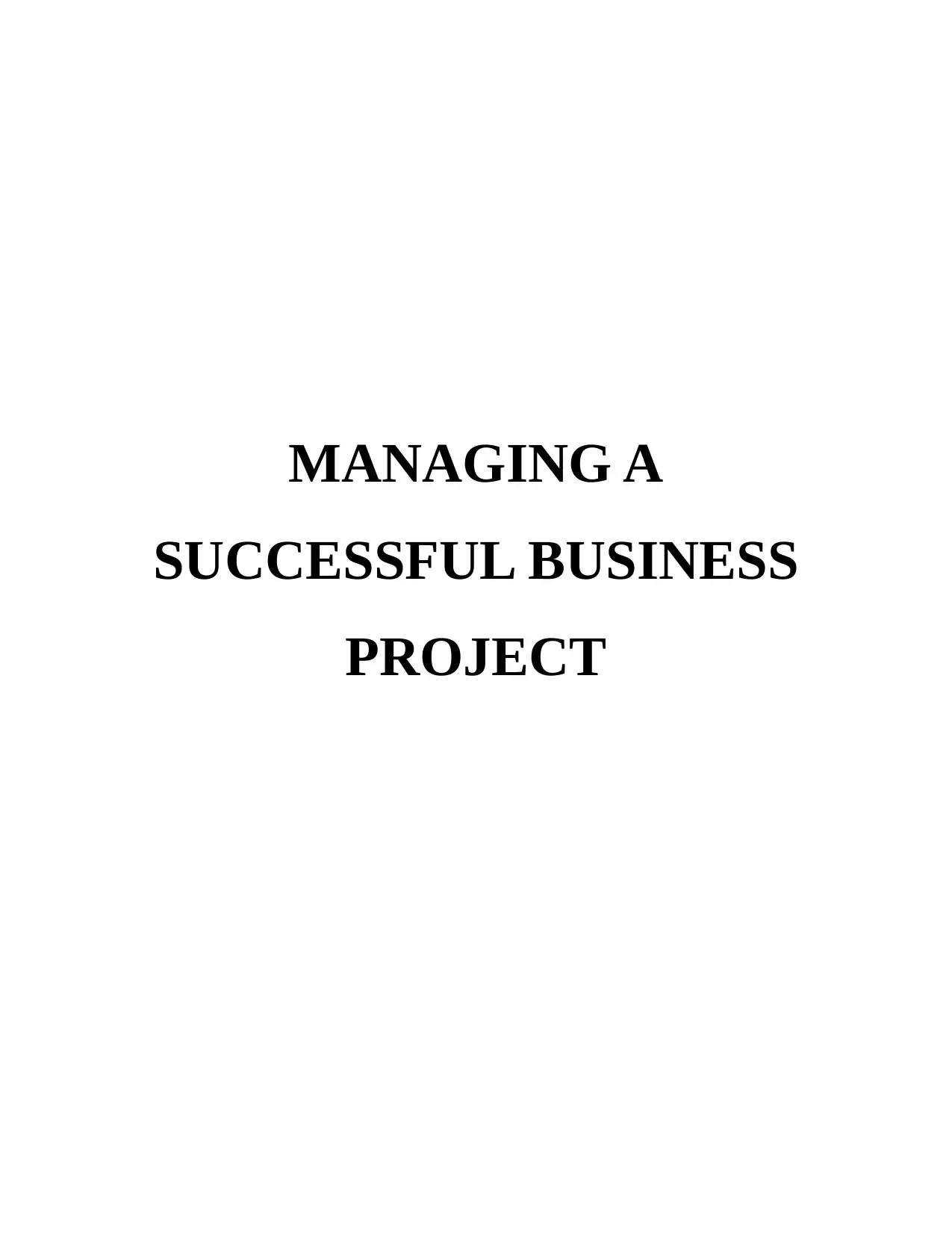
MANAGING A
SUCCESSFUL BUSINESS
PROJECT
SUCCESSFUL BUSINESS
PROJECT
Paraphrase This Document
Need a fresh take? Get an instant paraphrase of this document with our AI Paraphraser
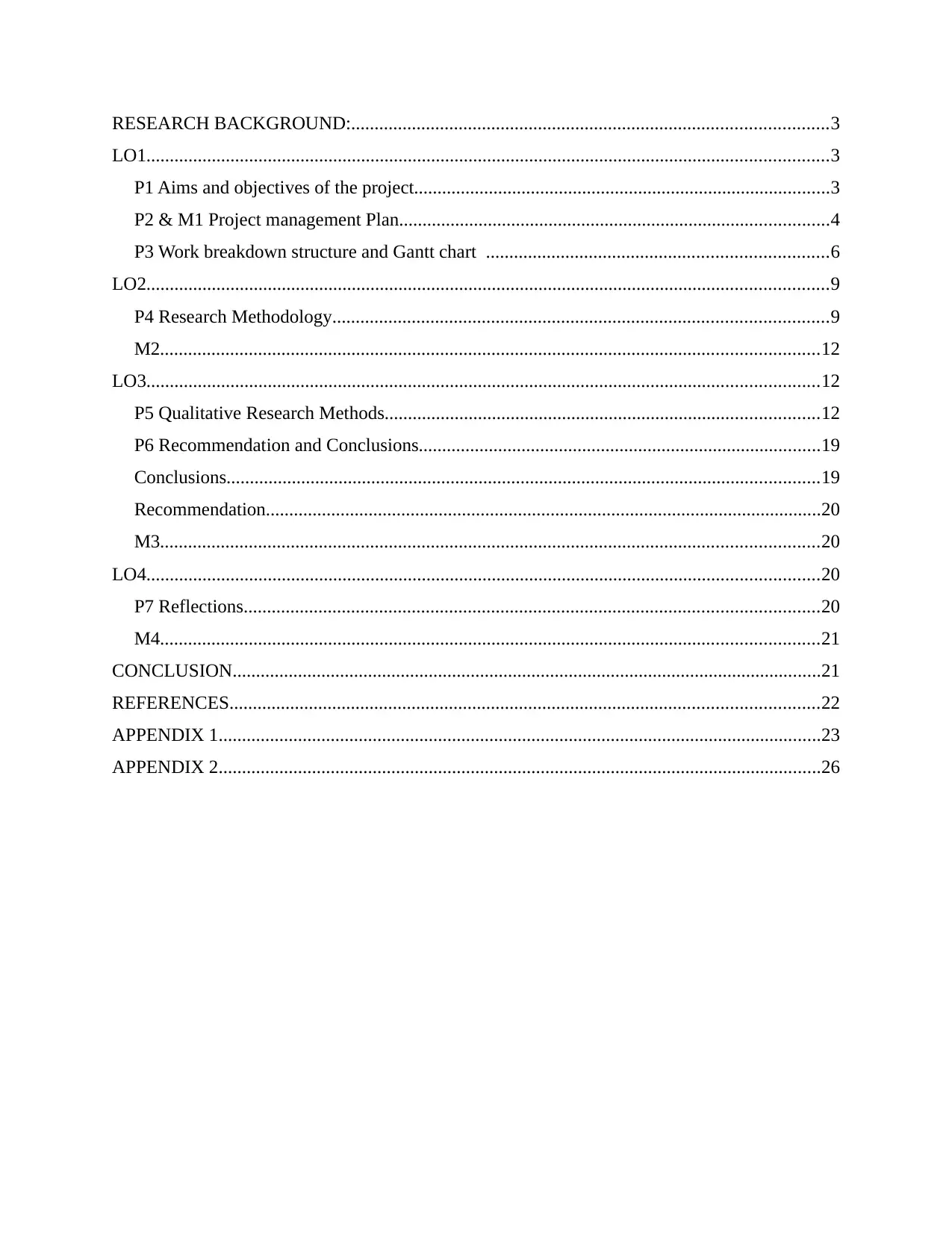
RESEARCH BACKGROUND:......................................................................................................3
LO1..................................................................................................................................................3
P1 Aims and objectives of the project.........................................................................................3
P2 & M1 Project management Plan............................................................................................4
P3 Work breakdown structure and Gantt chart .........................................................................6
LO2..................................................................................................................................................9
P4 Research Methodology..........................................................................................................9
M2.............................................................................................................................................12
LO3................................................................................................................................................12
P5 Qualitative Research Methods.............................................................................................12
P6 Recommendation and Conclusions......................................................................................19
Conclusions...............................................................................................................................19
Recommendation.......................................................................................................................20
M3.............................................................................................................................................20
LO4................................................................................................................................................20
P7 Reflections...........................................................................................................................20
M4.............................................................................................................................................21
CONCLUSION..............................................................................................................................21
REFERENCES..............................................................................................................................22
APPENDIX 1.................................................................................................................................23
APPENDIX 2.................................................................................................................................26
LO1..................................................................................................................................................3
P1 Aims and objectives of the project.........................................................................................3
P2 & M1 Project management Plan............................................................................................4
P3 Work breakdown structure and Gantt chart .........................................................................6
LO2..................................................................................................................................................9
P4 Research Methodology..........................................................................................................9
M2.............................................................................................................................................12
LO3................................................................................................................................................12
P5 Qualitative Research Methods.............................................................................................12
P6 Recommendation and Conclusions......................................................................................19
Conclusions...............................................................................................................................19
Recommendation.......................................................................................................................20
M3.............................................................................................................................................20
LO4................................................................................................................................................20
P7 Reflections...........................................................................................................................20
M4.............................................................................................................................................21
CONCLUSION..............................................................................................................................21
REFERENCES..............................................................................................................................22
APPENDIX 1.................................................................................................................................23
APPENDIX 2.................................................................................................................................26
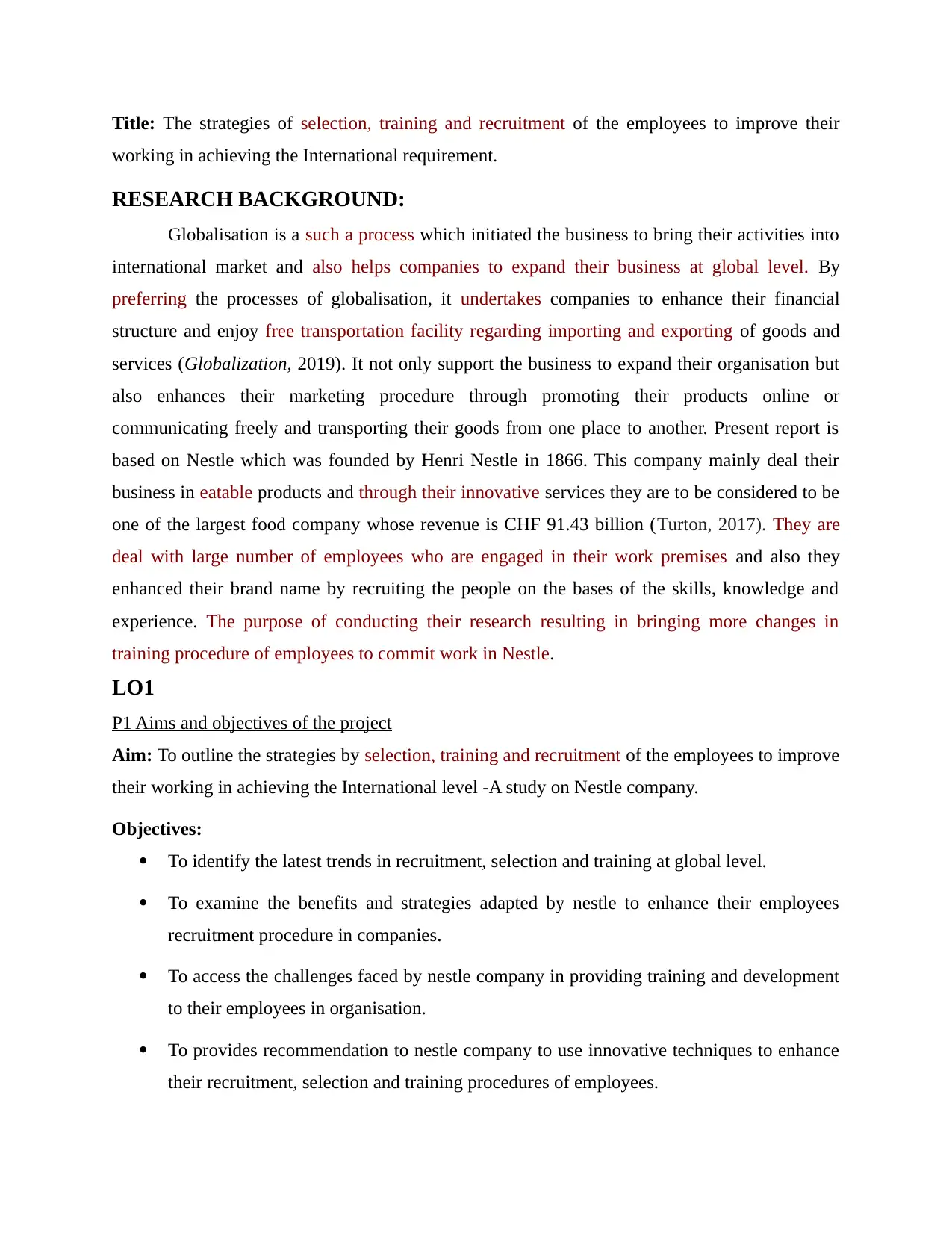
Title: The strategies of selection, training and recruitment of the employees to improve their
working in achieving the International requirement.
RESEARCH BACKGROUND:
Globalisation is a such a process which initiated the business to bring their activities into
international market and also helps companies to expand their business at global level. By
preferring the processes of globalisation, it undertakes companies to enhance their financial
structure and enjoy free transportation facility regarding importing and exporting of goods and
services (Globalization, 2019). It not only support the business to expand their organisation but
also enhances their marketing procedure through promoting their products online or
communicating freely and transporting their goods from one place to another. Present report is
based on Nestle which was founded by Henri Nestle in 1866. This company mainly deal their
business in eatable products and through their innovative services they are to be considered to be
one of the largest food company whose revenue is CHF 91.43 billion (Turton, 2017). They are
deal with large number of employees who are engaged in their work premises and also they
enhanced their brand name by recruiting the people on the bases of the skills, knowledge and
experience. The purpose of conducting their research resulting in bringing more changes in
training procedure of employees to commit work in Nestle.
LO1
P1 Aims and objectives of the project
Aim: To outline the strategies by selection, training and recruitment of the employees to improve
their working in achieving the International level -A study on Nestle company.
Objectives:
To identify the latest trends in recruitment, selection and training at global level.
To examine the benefits and strategies adapted by nestle to enhance their employees
recruitment procedure in companies.
To access the challenges faced by nestle company in providing training and development
to their employees in organisation.
To provides recommendation to nestle company to use innovative techniques to enhance
their recruitment, selection and training procedures of employees.
working in achieving the International requirement.
RESEARCH BACKGROUND:
Globalisation is a such a process which initiated the business to bring their activities into
international market and also helps companies to expand their business at global level. By
preferring the processes of globalisation, it undertakes companies to enhance their financial
structure and enjoy free transportation facility regarding importing and exporting of goods and
services (Globalization, 2019). It not only support the business to expand their organisation but
also enhances their marketing procedure through promoting their products online or
communicating freely and transporting their goods from one place to another. Present report is
based on Nestle which was founded by Henri Nestle in 1866. This company mainly deal their
business in eatable products and through their innovative services they are to be considered to be
one of the largest food company whose revenue is CHF 91.43 billion (Turton, 2017). They are
deal with large number of employees who are engaged in their work premises and also they
enhanced their brand name by recruiting the people on the bases of the skills, knowledge and
experience. The purpose of conducting their research resulting in bringing more changes in
training procedure of employees to commit work in Nestle.
LO1
P1 Aims and objectives of the project
Aim: To outline the strategies by selection, training and recruitment of the employees to improve
their working in achieving the International level -A study on Nestle company.
Objectives:
To identify the latest trends in recruitment, selection and training at global level.
To examine the benefits and strategies adapted by nestle to enhance their employees
recruitment procedure in companies.
To access the challenges faced by nestle company in providing training and development
to their employees in organisation.
To provides recommendation to nestle company to use innovative techniques to enhance
their recruitment, selection and training procedures of employees.
⊘ This is a preview!⊘
Do you want full access?
Subscribe today to unlock all pages.

Trusted by 1+ million students worldwide
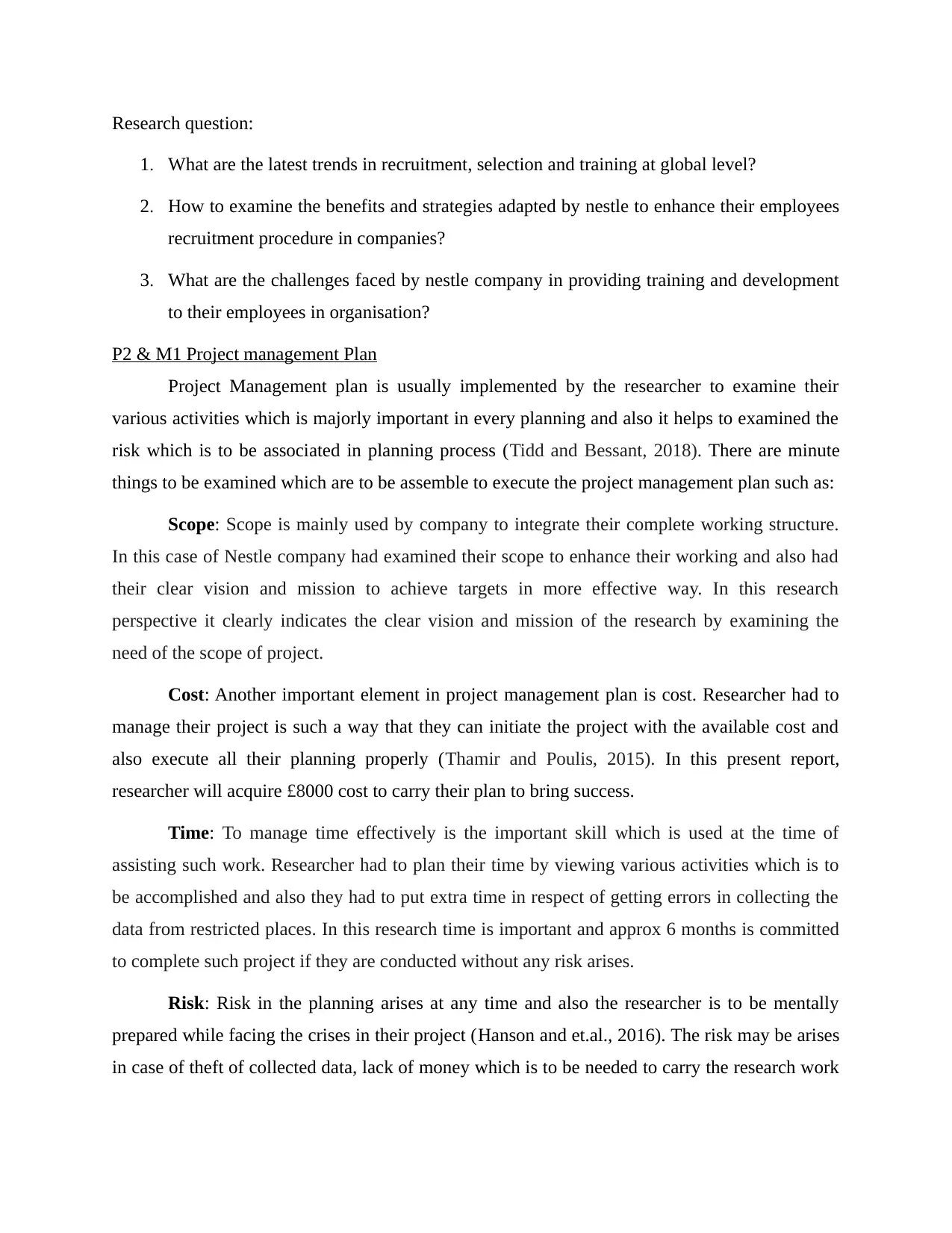
Research question:
1. What are the latest trends in recruitment, selection and training at global level?
2. How to examine the benefits and strategies adapted by nestle to enhance their employees
recruitment procedure in companies?
3. What are the challenges faced by nestle company in providing training and development
to their employees in organisation?
P2 & M1 Project management Plan
Project Management plan is usually implemented by the researcher to examine their
various activities which is majorly important in every planning and also it helps to examined the
risk which is to be associated in planning process (Tidd and Bessant, 2018). There are minute
things to be examined which are to be assemble to execute the project management plan such as:
Scope: Scope is mainly used by company to integrate their complete working structure.
In this case of Nestle company had examined their scope to enhance their working and also had
their clear vision and mission to achieve targets in more effective way. In this research
perspective it clearly indicates the clear vision and mission of the research by examining the
need of the scope of project.
Cost: Another important element in project management plan is cost. Researcher had to
manage their project is such a way that they can initiate the project with the available cost and
also execute all their planning properly (Thamir and Poulis, 2015). In this present report,
researcher will acquire £8000 cost to carry their plan to bring success.
Time: To manage time effectively is the important skill which is used at the time of
assisting such work. Researcher had to plan their time by viewing various activities which is to
be accomplished and also they had to put extra time in respect of getting errors in collecting the
data from restricted places. In this research time is important and approx 6 months is committed
to complete such project if they are conducted without any risk arises.
Risk: Risk in the planning arises at any time and also the researcher is to be mentally
prepared while facing the crises in their project (Hanson and et.al., 2016). The risk may be arises
in case of theft of collected data, lack of money which is to be needed to carry the research work
1. What are the latest trends in recruitment, selection and training at global level?
2. How to examine the benefits and strategies adapted by nestle to enhance their employees
recruitment procedure in companies?
3. What are the challenges faced by nestle company in providing training and development
to their employees in organisation?
P2 & M1 Project management Plan
Project Management plan is usually implemented by the researcher to examine their
various activities which is majorly important in every planning and also it helps to examined the
risk which is to be associated in planning process (Tidd and Bessant, 2018). There are minute
things to be examined which are to be assemble to execute the project management plan such as:
Scope: Scope is mainly used by company to integrate their complete working structure.
In this case of Nestle company had examined their scope to enhance their working and also had
their clear vision and mission to achieve targets in more effective way. In this research
perspective it clearly indicates the clear vision and mission of the research by examining the
need of the scope of project.
Cost: Another important element in project management plan is cost. Researcher had to
manage their project is such a way that they can initiate the project with the available cost and
also execute all their planning properly (Thamir and Poulis, 2015). In this present report,
researcher will acquire £8000 cost to carry their plan to bring success.
Time: To manage time effectively is the important skill which is used at the time of
assisting such work. Researcher had to plan their time by viewing various activities which is to
be accomplished and also they had to put extra time in respect of getting errors in collecting the
data from restricted places. In this research time is important and approx 6 months is committed
to complete such project if they are conducted without any risk arises.
Risk: Risk in the planning arises at any time and also the researcher is to be mentally
prepared while facing the crises in their project (Hanson and et.al., 2016). The risk may be arises
in case of theft of collected data, lack of money which is to be needed to carry the research work
Paraphrase This Document
Need a fresh take? Get an instant paraphrase of this document with our AI Paraphraser
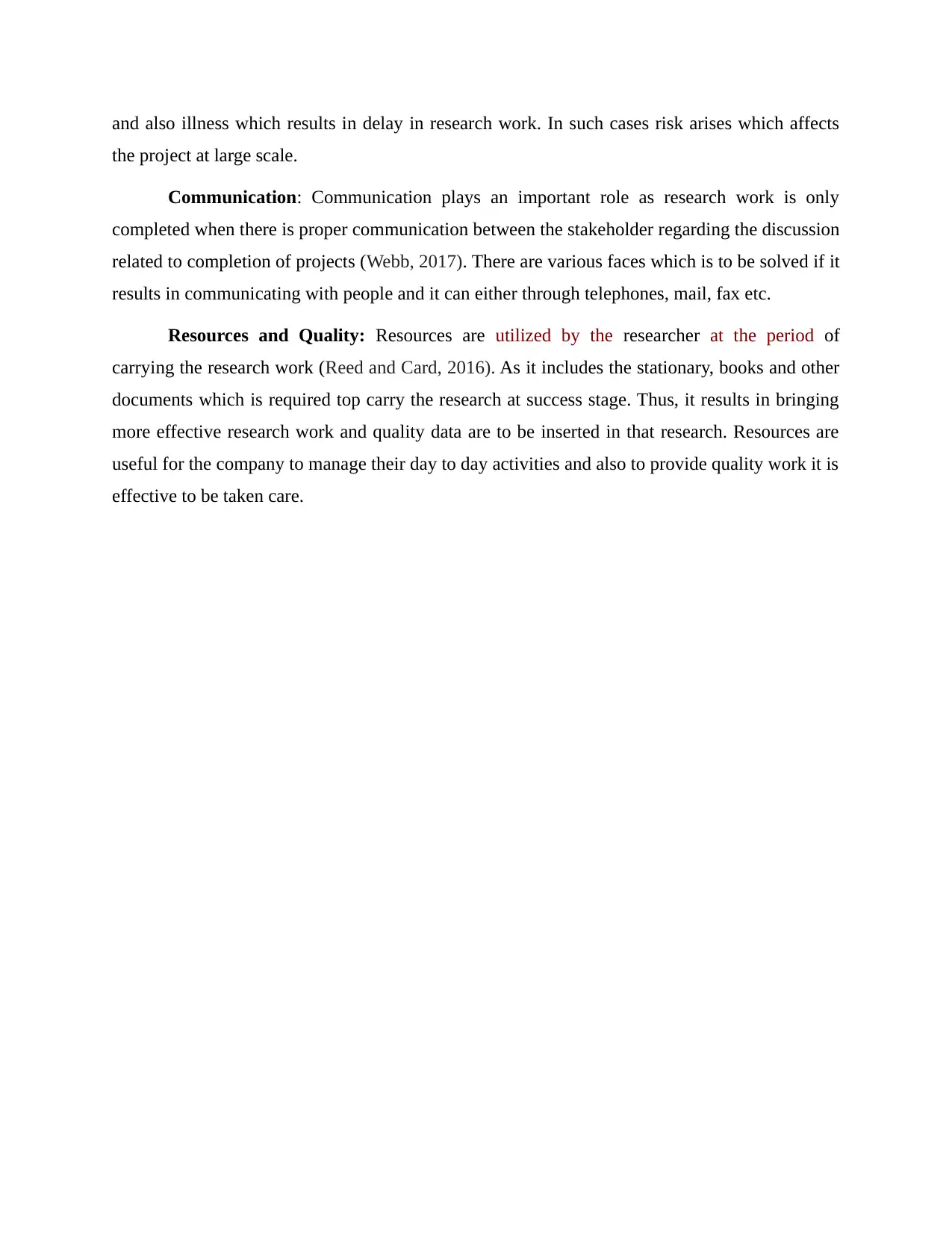
and also illness which results in delay in research work. In such cases risk arises which affects
the project at large scale.
Communication: Communication plays an important role as research work is only
completed when there is proper communication between the stakeholder regarding the discussion
related to completion of projects (Webb, 2017). There are various faces which is to be solved if it
results in communicating with people and it can either through telephones, mail, fax etc.
Resources and Quality: Resources are utilized by the researcher at the period of
carrying the research work (Reed and Card, 2016). As it includes the stationary, books and other
documents which is required top carry the research at success stage. Thus, it results in bringing
more effective research work and quality data are to be inserted in that research. Resources are
useful for the company to manage their day to day activities and also to provide quality work it is
effective to be taken care.
the project at large scale.
Communication: Communication plays an important role as research work is only
completed when there is proper communication between the stakeholder regarding the discussion
related to completion of projects (Webb, 2017). There are various faces which is to be solved if it
results in communicating with people and it can either through telephones, mail, fax etc.
Resources and Quality: Resources are utilized by the researcher at the period of
carrying the research work (Reed and Card, 2016). As it includes the stationary, books and other
documents which is required top carry the research at success stage. Thus, it results in bringing
more effective research work and quality data are to be inserted in that research. Resources are
useful for the company to manage their day to day activities and also to provide quality work it is
effective to be taken care.
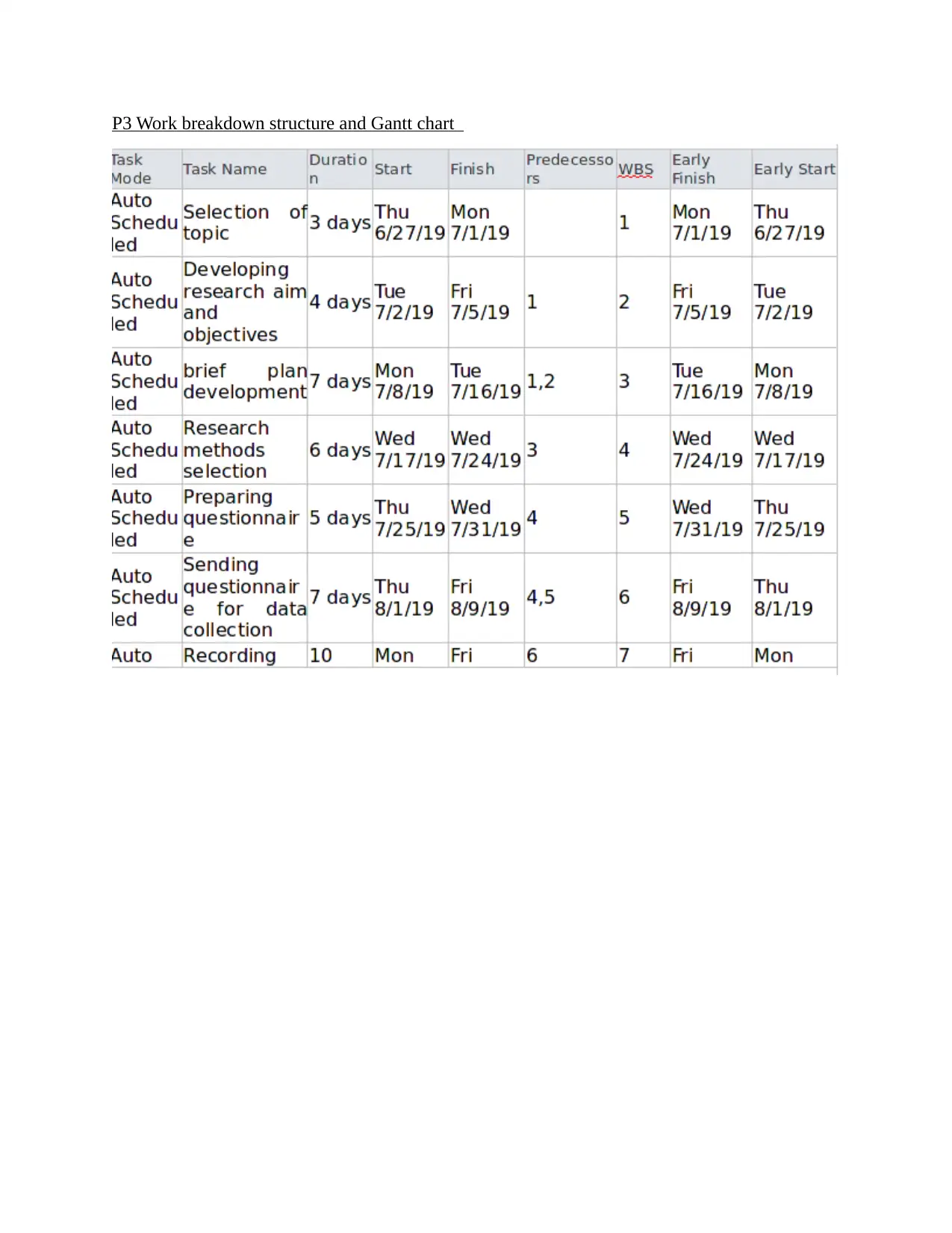
P3 Work breakdown structure and Gantt chart
⊘ This is a preview!⊘
Do you want full access?
Subscribe today to unlock all pages.

Trusted by 1+ million students worldwide
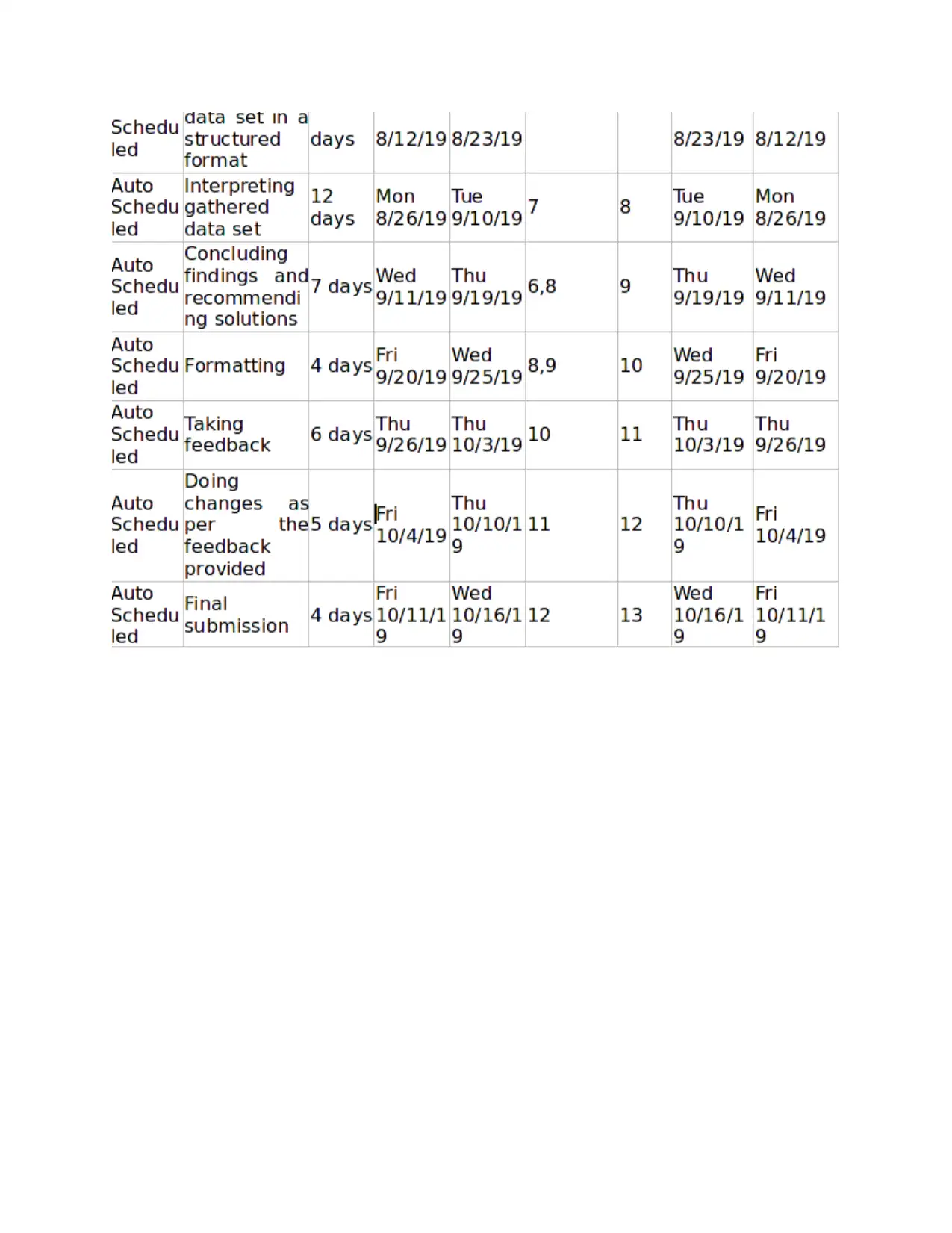
Paraphrase This Document
Need a fresh take? Get an instant paraphrase of this document with our AI Paraphraser
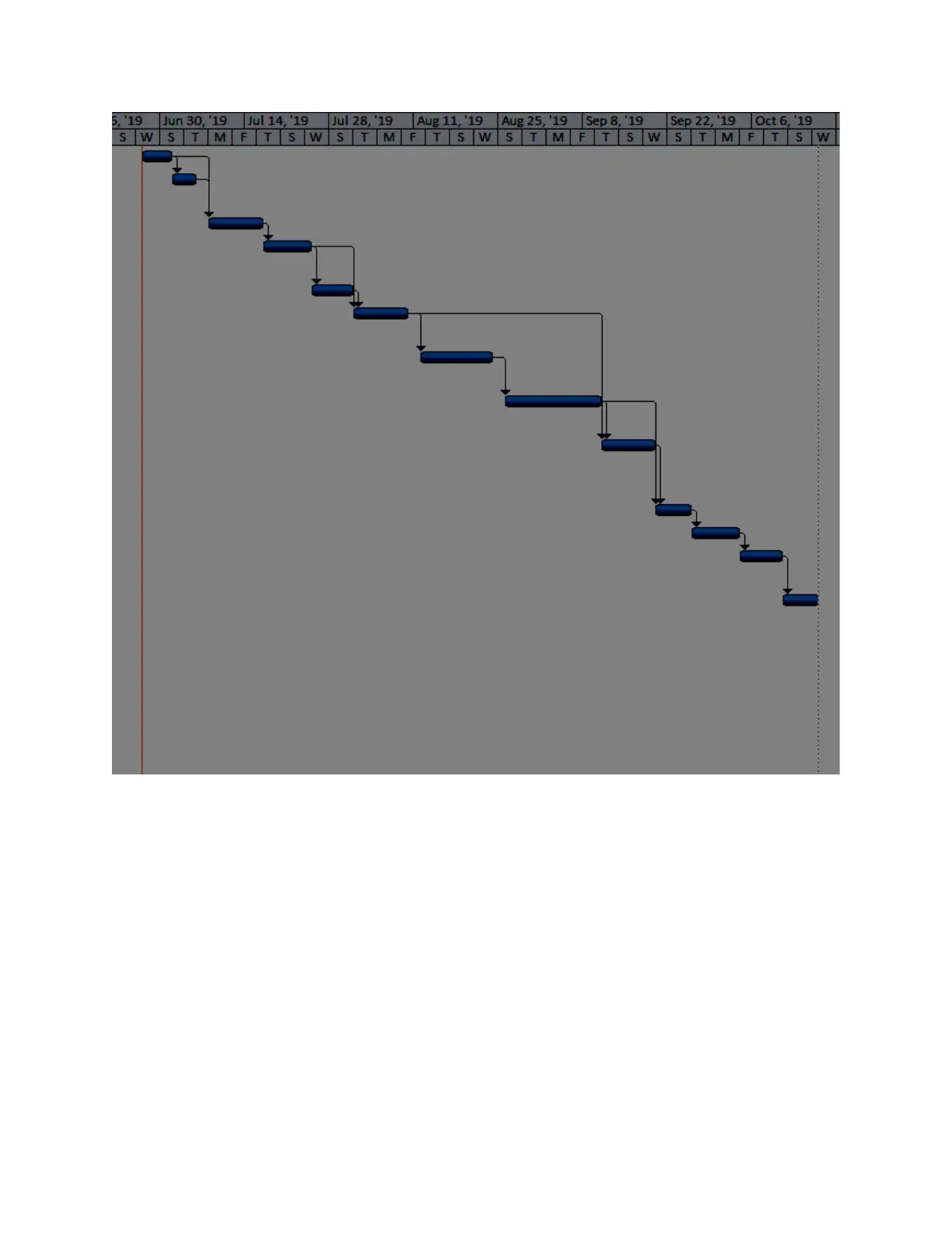
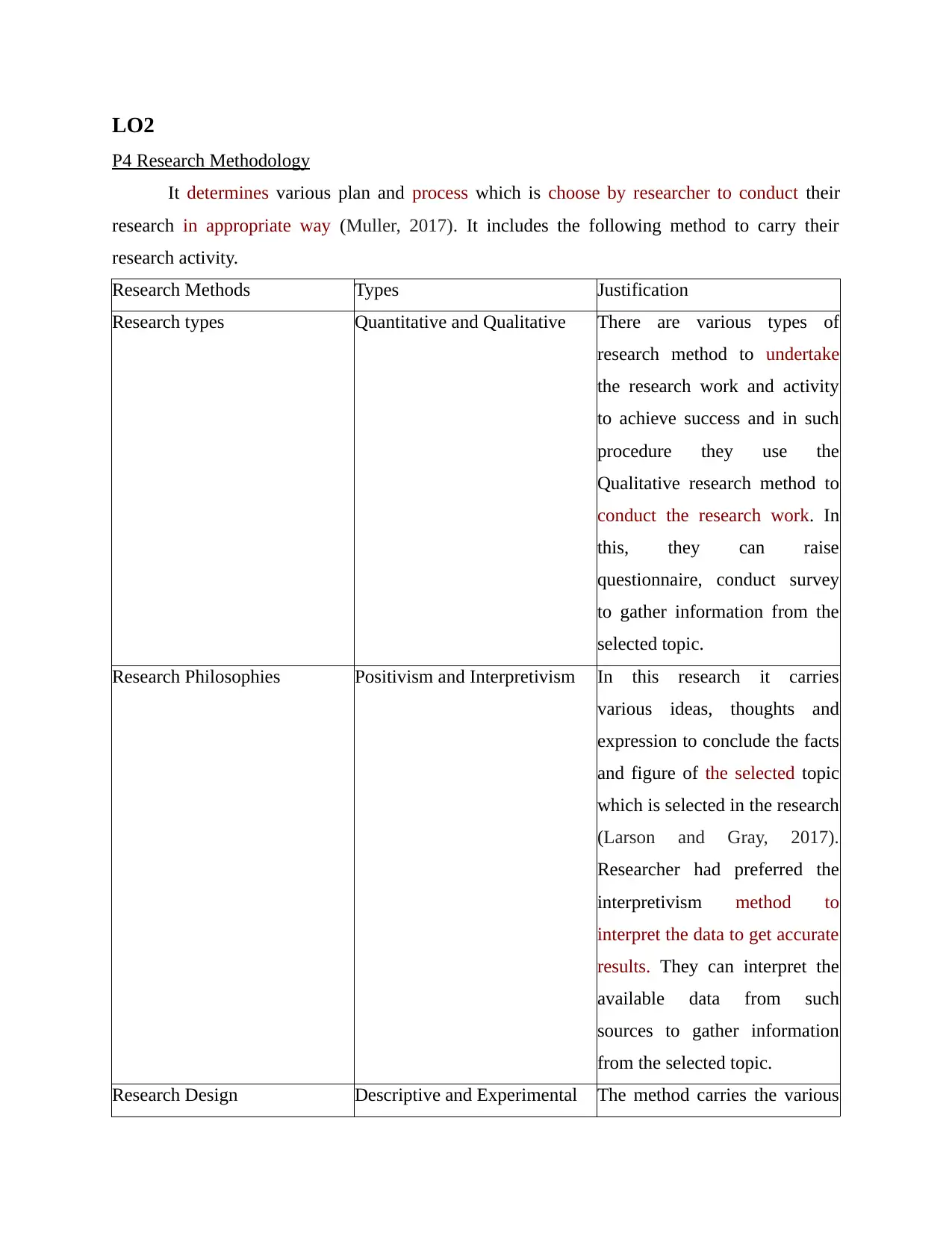
LO2
P4 Research Methodology
It determines various plan and process which is choose by researcher to conduct their
research in appropriate way (Muller, 2017). It includes the following method to carry their
research activity.
Research Methods Types Justification
Research types Quantitative and Qualitative There are various types of
research method to undertake
the research work and activity
to achieve success and in such
procedure they use the
Qualitative research method to
conduct the research work. In
this, they can raise
questionnaire, conduct survey
to gather information from the
selected topic.
Research Philosophies Positivism and Interpretivism In this research it carries
various ideas, thoughts and
expression to conclude the facts
and figure of the selected topic
which is selected in the research
(Larson and Gray, 2017).
Researcher had preferred the
interpretivism method to
interpret the data to get accurate
results. They can interpret the
available data from such
sources to gather information
from the selected topic.
Research Design Descriptive and Experimental The method carries the various
P4 Research Methodology
It determines various plan and process which is choose by researcher to conduct their
research in appropriate way (Muller, 2017). It includes the following method to carry their
research activity.
Research Methods Types Justification
Research types Quantitative and Qualitative There are various types of
research method to undertake
the research work and activity
to achieve success and in such
procedure they use the
Qualitative research method to
conduct the research work. In
this, they can raise
questionnaire, conduct survey
to gather information from the
selected topic.
Research Philosophies Positivism and Interpretivism In this research it carries
various ideas, thoughts and
expression to conclude the facts
and figure of the selected topic
which is selected in the research
(Larson and Gray, 2017).
Researcher had preferred the
interpretivism method to
interpret the data to get accurate
results. They can interpret the
available data from such
sources to gather information
from the selected topic.
Research Design Descriptive and Experimental The method carries the various
⊘ This is a preview!⊘
Do you want full access?
Subscribe today to unlock all pages.

Trusted by 1+ million students worldwide
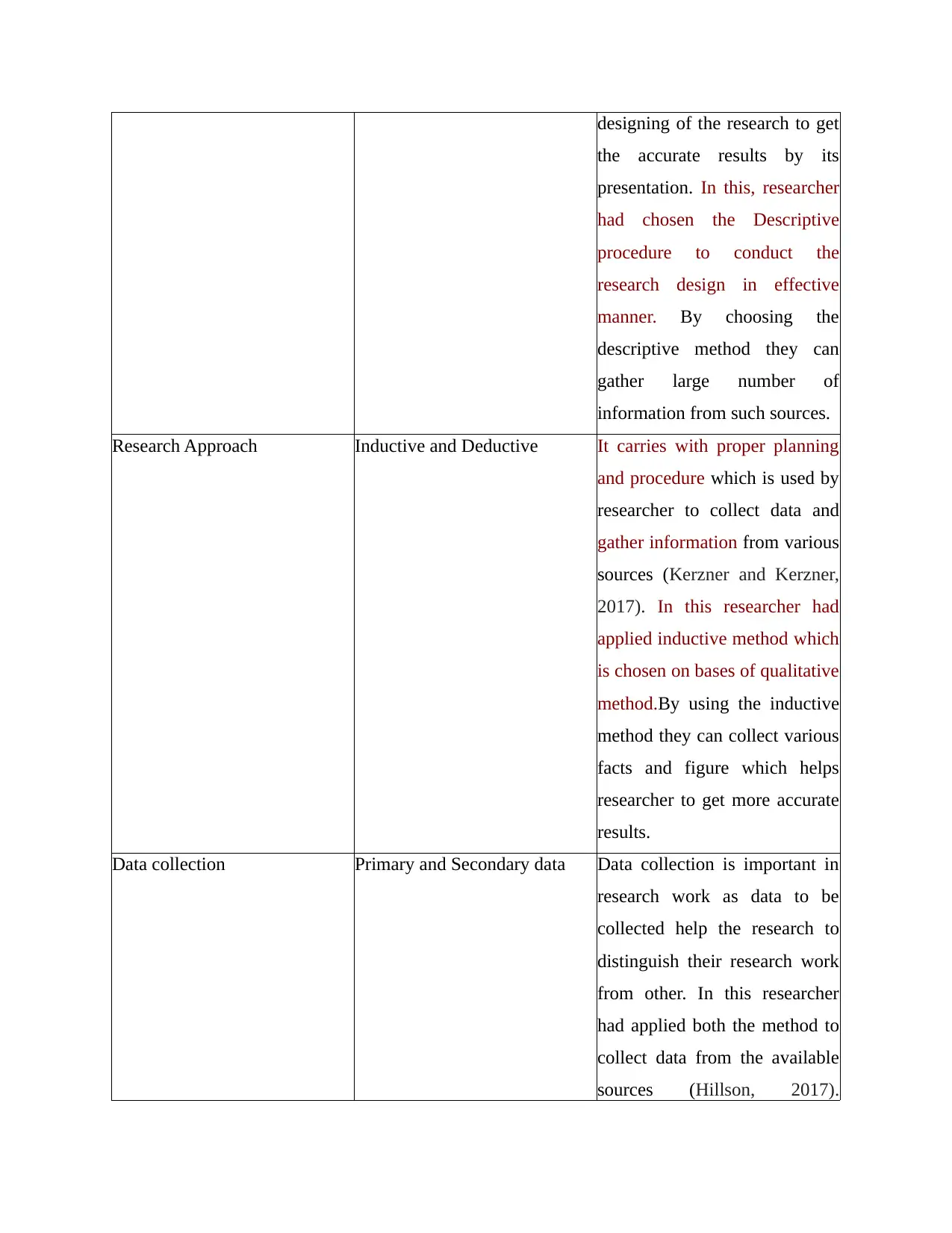
designing of the research to get
the accurate results by its
presentation. In this, researcher
had chosen the Descriptive
procedure to conduct the
research design in effective
manner. By choosing the
descriptive method they can
gather large number of
information from such sources.
Research Approach Inductive and Deductive It carries with proper planning
and procedure which is used by
researcher to collect data and
gather information from various
sources (Kerzner and Kerzner,
2017). In this researcher had
applied inductive method which
is chosen on bases of qualitative
method.By using the inductive
method they can collect various
facts and figure which helps
researcher to get more accurate
results.
Data collection Primary and Secondary data Data collection is important in
research work as data to be
collected help the research to
distinguish their research work
from other. In this researcher
had applied both the method to
collect data from the available
sources (Hillson, 2017).
the accurate results by its
presentation. In this, researcher
had chosen the Descriptive
procedure to conduct the
research design in effective
manner. By choosing the
descriptive method they can
gather large number of
information from such sources.
Research Approach Inductive and Deductive It carries with proper planning
and procedure which is used by
researcher to collect data and
gather information from various
sources (Kerzner and Kerzner,
2017). In this researcher had
applied inductive method which
is chosen on bases of qualitative
method.By using the inductive
method they can collect various
facts and figure which helps
researcher to get more accurate
results.
Data collection Primary and Secondary data Data collection is important in
research work as data to be
collected help the research to
distinguish their research work
from other. In this researcher
had applied both the method to
collect data from the available
sources (Hillson, 2017).
Paraphrase This Document
Need a fresh take? Get an instant paraphrase of this document with our AI Paraphraser
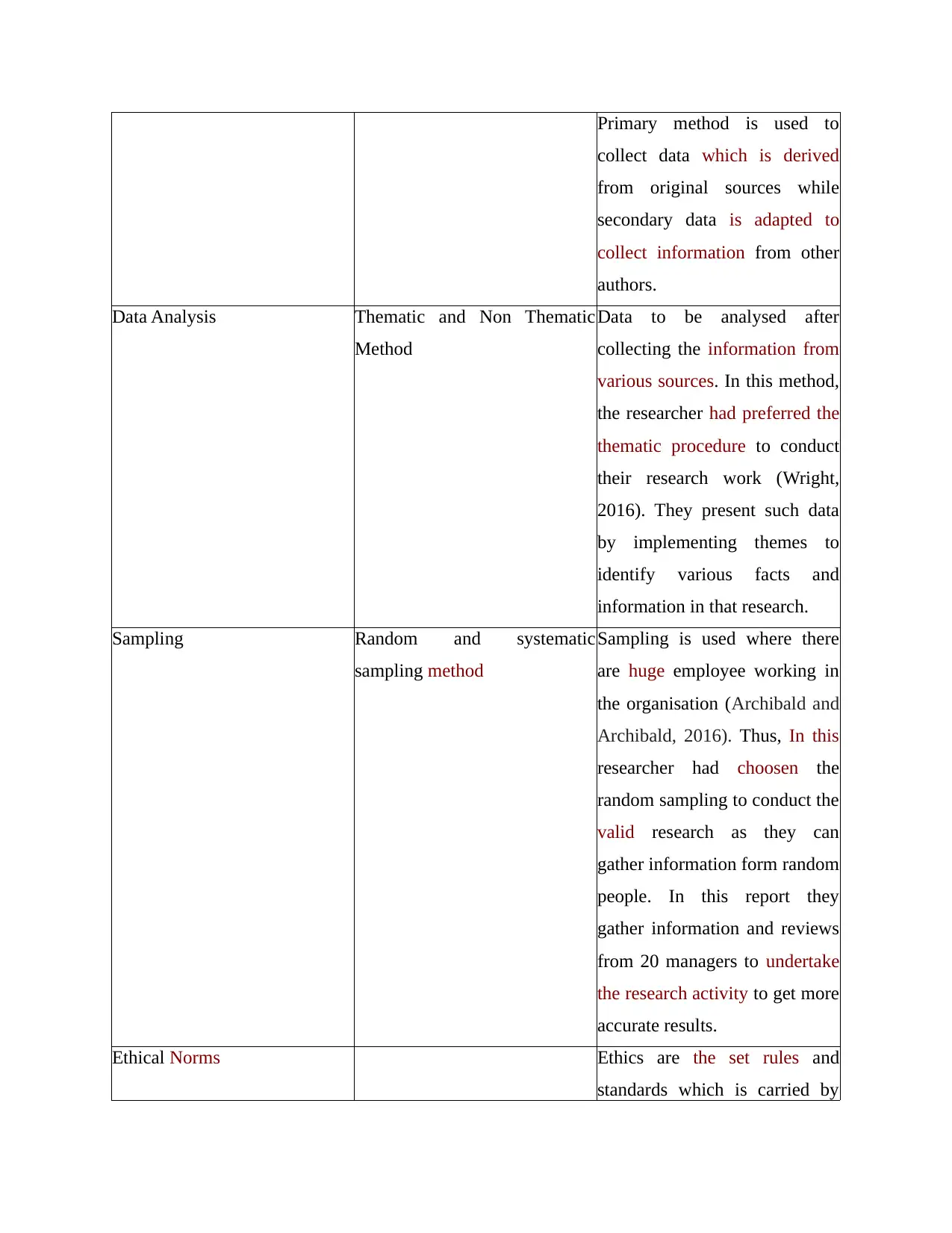
Primary method is used to
collect data which is derived
from original sources while
secondary data is adapted to
collect information from other
authors.
Data Analysis Thematic and Non Thematic
Method
Data to be analysed after
collecting the information from
various sources. In this method,
the researcher had preferred the
thematic procedure to conduct
their research work (Wright,
2016). They present such data
by implementing themes to
identify various facts and
information in that research.
Sampling Random and systematic
sampling method
Sampling is used where there
are huge employee working in
the organisation (Archibald and
Archibald, 2016). Thus, In this
researcher had choosen the
random sampling to conduct the
valid research as they can
gather information form random
people. In this report they
gather information and reviews
from 20 managers to undertake
the research activity to get more
accurate results.
Ethical Norms Ethics are the set rules and
standards which is carried by
collect data which is derived
from original sources while
secondary data is adapted to
collect information from other
authors.
Data Analysis Thematic and Non Thematic
Method
Data to be analysed after
collecting the information from
various sources. In this method,
the researcher had preferred the
thematic procedure to conduct
their research work (Wright,
2016). They present such data
by implementing themes to
identify various facts and
information in that research.
Sampling Random and systematic
sampling method
Sampling is used where there
are huge employee working in
the organisation (Archibald and
Archibald, 2016). Thus, In this
researcher had choosen the
random sampling to conduct the
valid research as they can
gather information form random
people. In this report they
gather information and reviews
from 20 managers to undertake
the research activity to get more
accurate results.
Ethical Norms Ethics are the set rules and
standards which is carried by
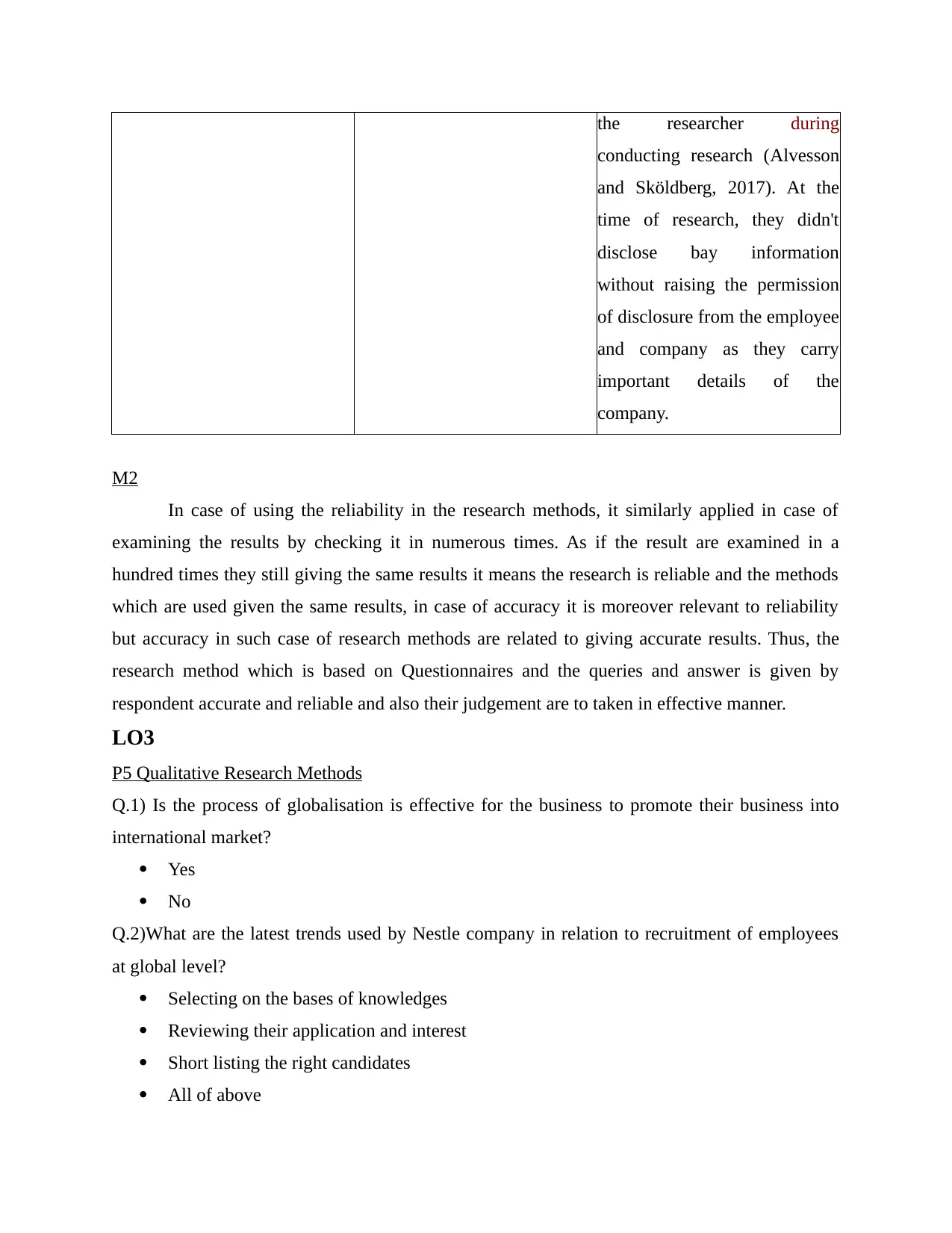
the researcher during
conducting research (Alvesson
and Sköldberg, 2017). At the
time of research, they didn't
disclose bay information
without raising the permission
of disclosure from the employee
and company as they carry
important details of the
company.
M2
In case of using the reliability in the research methods, it similarly applied in case of
examining the results by checking it in numerous times. As if the result are examined in a
hundred times they still giving the same results it means the research is reliable and the methods
which are used given the same results, in case of accuracy it is moreover relevant to reliability
but accuracy in such case of research methods are related to giving accurate results. Thus, the
research method which is based on Questionnaires and the queries and answer is given by
respondent accurate and reliable and also their judgement are to taken in effective manner.
LO3
P5 Qualitative Research Methods
Q.1) Is the process of globalisation is effective for the business to promote their business into
international market?
Yes
No
Q.2)What are the latest trends used by Nestle company in relation to recruitment of employees
at global level?
Selecting on the bases of knowledges
Reviewing their application and interest
Short listing the right candidates
All of above
conducting research (Alvesson
and Sköldberg, 2017). At the
time of research, they didn't
disclose bay information
without raising the permission
of disclosure from the employee
and company as they carry
important details of the
company.
M2
In case of using the reliability in the research methods, it similarly applied in case of
examining the results by checking it in numerous times. As if the result are examined in a
hundred times they still giving the same results it means the research is reliable and the methods
which are used given the same results, in case of accuracy it is moreover relevant to reliability
but accuracy in such case of research methods are related to giving accurate results. Thus, the
research method which is based on Questionnaires and the queries and answer is given by
respondent accurate and reliable and also their judgement are to taken in effective manner.
LO3
P5 Qualitative Research Methods
Q.1) Is the process of globalisation is effective for the business to promote their business into
international market?
Yes
No
Q.2)What are the latest trends used by Nestle company in relation to recruitment of employees
at global level?
Selecting on the bases of knowledges
Reviewing their application and interest
Short listing the right candidates
All of above
⊘ This is a preview!⊘
Do you want full access?
Subscribe today to unlock all pages.

Trusted by 1+ million students worldwide
1 out of 27
Related Documents
Your All-in-One AI-Powered Toolkit for Academic Success.
+13062052269
info@desklib.com
Available 24*7 on WhatsApp / Email
![[object Object]](/_next/static/media/star-bottom.7253800d.svg)
Unlock your academic potential
Copyright © 2020–2025 A2Z Services. All Rights Reserved. Developed and managed by ZUCOL.





